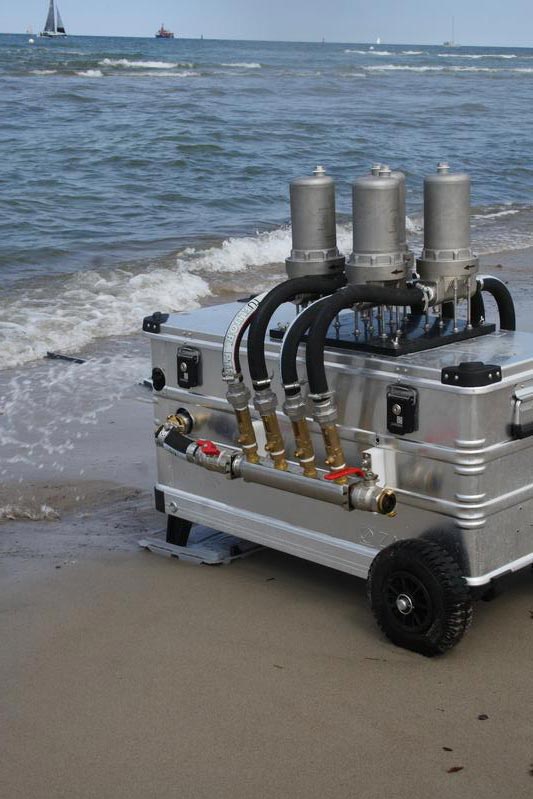Enabling a plastic-free microplastic hunt: "Rocket" improves detection of very small particles

The "Rocket" operating at Warnemünde beach Robin Lenz / IOW
Microplastics are omnipresent in the environment. Whether in the Arctic ice, the sand of the Sahara or the sediments of the deep sea – environmental researchers find these artificial particles everywhere. Figures on how much of this occurs in the environment, however, are usually based on estimates only.
Due to its variable behaviour in the environment, its similarity to natural components and the fact that microplastics are often masked by biofilm growth, it is difficult and time-consuming to record these particles.
To make matters worse, in our plastic world the postulate of contamination-free sampling also poses an enormous challenge: whether it is the clothing of the sample taker, the sampling equipment or the sample vessels themselves: any plastic material must be avoided when microplastics are detected.
Robin Lenz and Matthias Labrenz, the authors of the scientific article in “Water”, are investigating the main entry pathways for microplastics into the Baltic Sea along a river system, and under which circumstances microplastics already introduced in the course of the river can be removed again. Their “model river” is the Warnow. For the extensive sampling campaigns, they now developed a device, which, in its silvery aluminium box equipped with hoses and levers, looks like the props of a 70s science fiction movie and was therefore nicknamed “The Rocket”.
“Rocket” offers many advantages over conventional sampling techniques. Two effects in particular had to be avoided: Conventional techniques, which usually use plankton nets for sampling, are particularly prone to errors in fine microplastics in the micrometer range.
Either the mesh size of the nets is too large to catch the very small microplastic fraction, or, in the case of very small mesh sizes, the nets quickly clog. Swirls in the area of the net opening then drive the microplastic out of the net again.
This does no longer happen with the parallel cartridge filters in the closed “Rocket” system. All particles larger than 10 µm are collected. Another disadvantage of the net technology was eliminated with the “Rocket”, too: The device is constructed almost completely without plastic.
Only one type of plastic, the relatively rare PTFE (polytetrafluoroethylene), was used inside the closed system. This means that contamination-free sampling can be assumed for all other plastic polymers.
The MicroCatch_Balt project is funded by the German Federal Ministry of Education and Research (BMBF) within the research focus Plastics in the Environment. The research focus “Plastics in the environment – Sources, sinks, solutions” is part of the Green Economy lead initiative of the BMBF framework programme “Research for Sustainable Development” (FONA3).
Press and public relation:
Dr. Barbara Hentzsch | +49 381 5197-102 | barbara.hentzsch@io-warnemuende.de
Dr. Kristin Beck | +49 381 5197-135 | kristin.beck@io-warnemuende.de
IOW is a member of the Leibniz Association with currently 93 research institutes and scientific infrastructure facilities. The focus of the Leibniz Institutes ranges from natural, engineering and environmental sciences to economic, social and space sciences as well as to the humanities. The institutes are jointly financed at the state and national levels. The Leibniz Institutes employ a total of 19.100 people, of whom 9.900 are scientists. The total budget of the institutes is 1.9 billion Euros. (http://www.leibniz-association.eu)
Robin Lenz | robin.lenz@io-warnemuende.de
PD Dr. Matthias Labrenz | matthias.labrenz@io-warnemuende.de
Working Group Environmental Microbiology, Leibniz Institute for Baltic Sea Research Warnemünde
Lenz, R.; Labrenz, M.: Small Microplastic Sampling in Water: Development of an Encapsulated Filtration Device. Water 2018, 10, 1055; DOI: 10.3390/w10081055; URL: http://www.mdpi.com/2073-4441/10/8/1055.
Media Contact
All latest news from the category: Ecology, The Environment and Conservation
This complex theme deals primarily with interactions between organisms and the environmental factors that impact them, but to a greater extent between individual inanimate environmental factors.
innovations-report offers informative reports and articles on topics such as climate protection, landscape conservation, ecological systems, wildlife and nature parks and ecosystem efficiency and balance.
Newest articles

NASA: Mystery of life’s handedness deepens
The mystery of why life uses molecules with specific orientations has deepened with a NASA-funded discovery that RNA — a key molecule thought to have potentially held the instructions for…

What are the effects of historic lithium mining on water quality?
Study reveals low levels of common contaminants but high levels of other elements in waters associated with an abandoned lithium mine. Lithium ore and mining waste from a historic lithium…

Quantum-inspired design boosts efficiency of heat-to-electricity conversion
Rice engineers take unconventional route to improving thermophotovoltaic systems. Researchers at Rice University have found a new way to improve a key element of thermophotovoltaic (TPV) systems, which convert heat…



